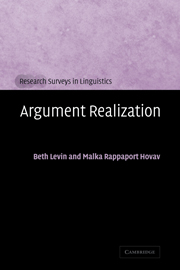Book contents
- Frontmatter
- Contents
- Acknowledgments
- Introduction
- 1 Challenges for theories of argument realization
- 2 Semantic role lists
- 3 Current approaches to lexical semantic representation
- 4 Three conceptualizations of events
- 5 The mapping from lexical semantics to syntax
- 6 Thematic hierarchies in argument realization
- 7 Multiple argument realization
- 8 Postscript
- References
- Index of topics
- Index of authors
- Index of languages
3 - Current approaches to lexical semantic representation
Published online by Cambridge University Press: 28 October 2009
- Frontmatter
- Contents
- Acknowledgments
- Introduction
- 1 Challenges for theories of argument realization
- 2 Semantic role lists
- 3 Current approaches to lexical semantic representation
- 4 Three conceptualizations of events
- 5 The mapping from lexical semantics to syntax
- 6 Thematic hierarchies in argument realization
- 7 Multiple argument realization
- 8 Postscript
- References
- Index of topics
- Index of authors
- Index of languages
Summary
As we discussed in the last chapter, a general consensus has emerged that semantic roles, to the extent that they do figure in argument realization, cannot be considered unanalyzable notions. We reviewed two approaches to overcoming this problem: unpackaging the content of semantic roles in terms of bundles of binary features and allowing arguments to be assigned more than one semantic role. In this chapter, we survey two other widely adopted solutions. The first involves introducing what Van Valin (1999) calls “generalized semantic roles.” On this approach the content of traditional semantic roles is unpackaged into more basic components, as in the feature decomposition approach, but these components do not constitute a set of jointly necessary and sufficient conditions on any given role. The second involves introducing a more structured lexical semantic representation known as a predicate decomposition. The most sophisticated of the current theories of argument realization build on generalized semantic roles, predicate decompositions, or both. Section 3.1 introduces generalized semantic roles, while section 3.2 introduces predicate decompositions.
Generalized semantic roles
The difficulties that arise in identifying a semantic role inventory and in assigning semantic roles to certain NPs have led some researchers to reject the traditional assumption that the semantic roles relevant for argument realization are characterized by a set of jointly necessary and sufficient conditions. In so doing, they are able to posit semantic roles that lump together arguments that pattern in the same way with respect to morphosyntax, without requiring that they have a single common semantic ingredient.
- Type
- Chapter
- Information
- Argument Realization , pp. 51 - 77Publisher: Cambridge University PressPrint publication year: 2005

